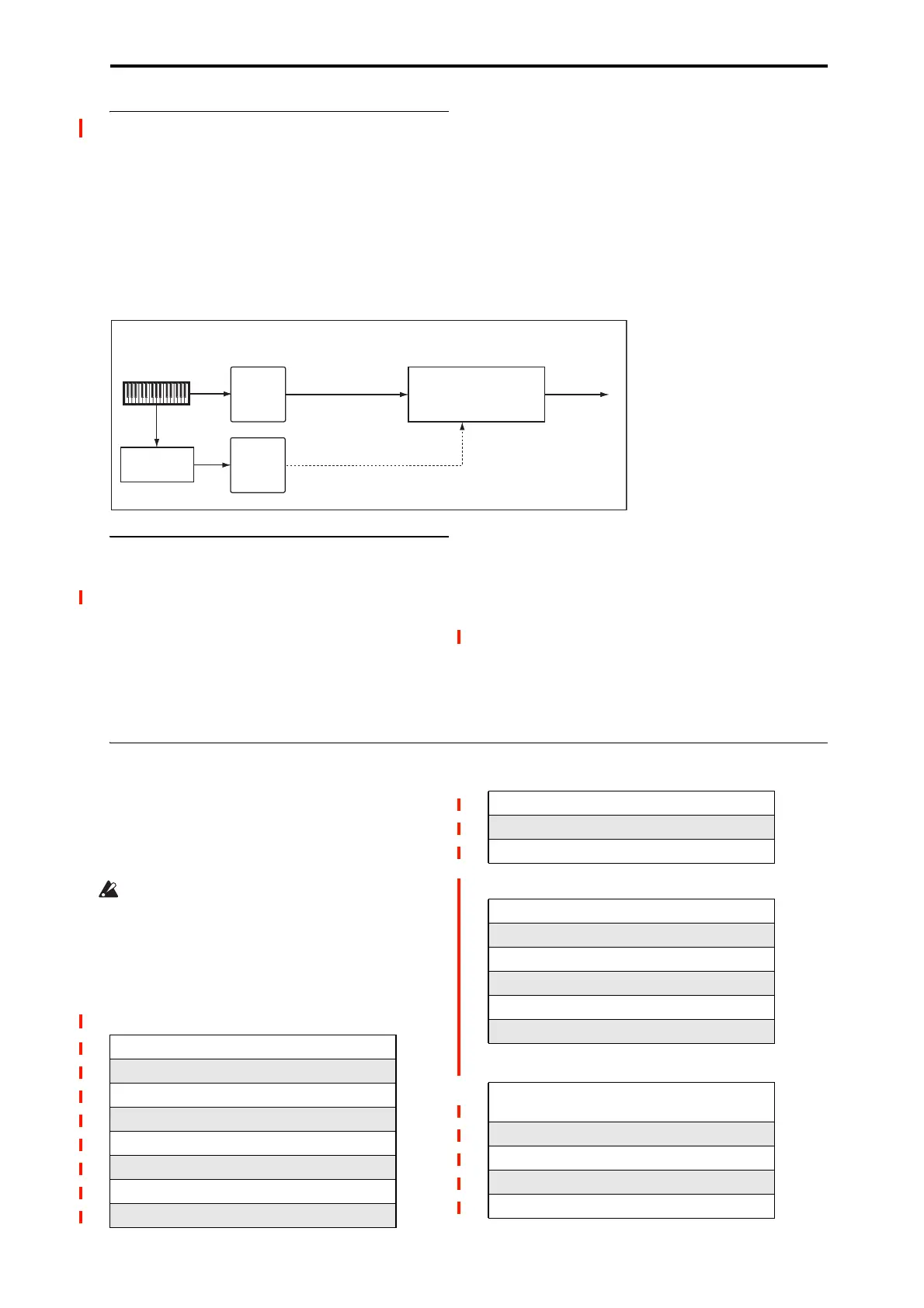Overview Effect I/O
735
Rhythmic Vocoder (COMBINATION mode)
Vocoder effects produce their distinctive sound by using an
audio signal (the modulator) to modulate a different audio
signal (the carrier). Although the most common application
of a vocoder is to use audio from a mic as the modulator, you
can also use a drum pattern or similar signal as the
modulator, producing a rhythmic effect.
In the example shown in the diagram, a drum pattern
generated by ARP is sent to an FX Control bus and used as
the modulator for the vocoder. To do this:
1. For Timbre 1 (the carrier), set Bus Select to IFX1.
This sends the signal to the Vocoder, as the carrier.
2. For Timbre 2 (the drum program we’re using as the
modulator), set FX Control Bus to FX Ctrl1.
This sends the signal from Timbre 2 to FX Control Bus 1.
3. In IFX1: Vocoder, set the Modulator Source to FX
Control 1.
Now, through FX Control Bus 1, Timbre 2 is the modulator
for the vocoder.
Parallel Effects routing
You can create parallel effects paths using the FX Control
Buses. You’ll need to use one IFX slot to do so, however.
1. Route the signal (program, IFX output, etc.) to an
output or IFX bus as normal.
2. In addition to the normal bus, assign it to one of the
FX Control Buses.
3. Place an effect which uses the FX Control Buses - the
Stereo Compressor, for instance - on any IFX.
4. In the Stereo Compressor, set the Envelope Source to
the FX Control Bus from step 2.
5. Also in the Stereo Compressor, enable the check-box
labeled Side Chain Monitor.
Enabling Side Chain Monitor means that, instead of
hearing the output of the compressor, you’ll hear the FX
Control Bus input. You can save the effect in this state.
At this point, the compressor is simply serving as a way to
access the FX Control Bus, and you can use it to start the
parallel branch of the effects chain.
Effect I/O
To achieve the best tonal quality, signals sent to the effects
should be at the maximum level below clipping. Also, use
the Wet/Dry parameter for the Insert Effects, Total Effects
and the Output Level or Return 1/ 2 parameters for the
Master Effects to adjust the effect output level.
If the input level is too low, the SN ratio may decrease.
On the other hand, if the input level is too high, clipping
may occur.
The Global Internal Headroom setting will also change
the maximum input level of the effect.
The following tables show the parameters related to volume
level:
PROGRAM mode (HD-1)
PROGRAM mode (EXi: Common)
PROGRAM mode (AL-1)
IFX1
026: Vocoder
Timbre1
: Pad
Bus Select
: IFX1
FX Control Bus
: FX Ctrl1
Modulator Source
: FX Control 1
Rhythmic Vocoder (Combination)
Bus Select
: L/R
(FX Control Bus1)
(Carrier)
(Modulator)
Timbre2
: Drums
DRUM
OSC1/2 MS1…8 Level (OSC/Pitch page)
Filter1/2 Input Trim (Filter page)
Filter1/2 Output Level (Filter page)
Driver1/2 Drive (Amp/EQ page)
Amp1/2 Amp Level (Amp/EQ page)
EQ Input Trim (Amp/EQ page)
Send1/2 (IFX page)
Effect Trim parameter
*1
(IFX page, MFX/TFX page)
Effect Wet/Dry parameter (IFX page, MFX/TFX page)
Return1, 2 (MFX/TFX page)
Master Volume (MFX/TFX page)
EQ Input Trim (EQ page)
Send1/2 (IFX page)
Effect Trim parameter
*1
(IFX page, MFX/TFX page)
Effect Wet/Dry parameter (IFX page, MFX/TFX page)
Return1, 2 (MFX/TFX page)
Master Volume (MFX/TFX page)
OSC Mixer Level (OSC1, OSC2, Sub OSC, Ring Mod.,
Noise) (AL-1: OSC/Pitch page)
Filter1/2 Input Trim (Filter page)
Filter1/2 Output Level (Filter page)
Driver1/2 Drive (AL-1: Amp page)
Amp1/2 Amp Level (AL-1: Amp page)

